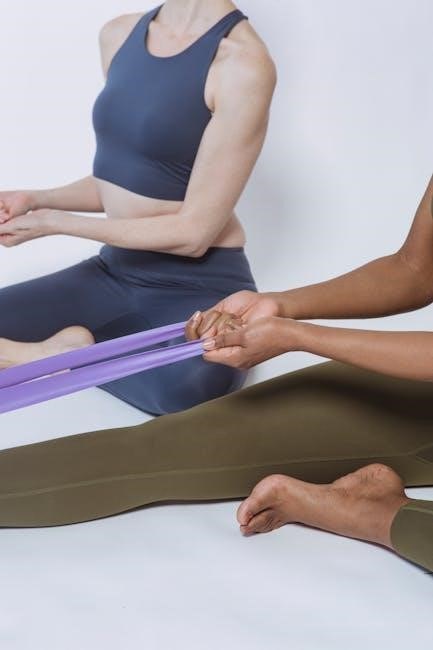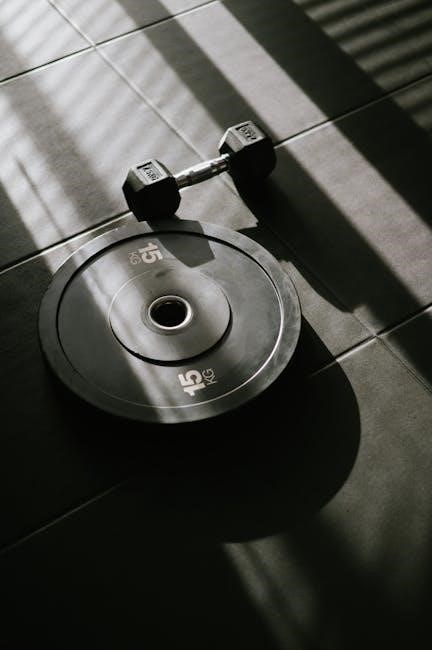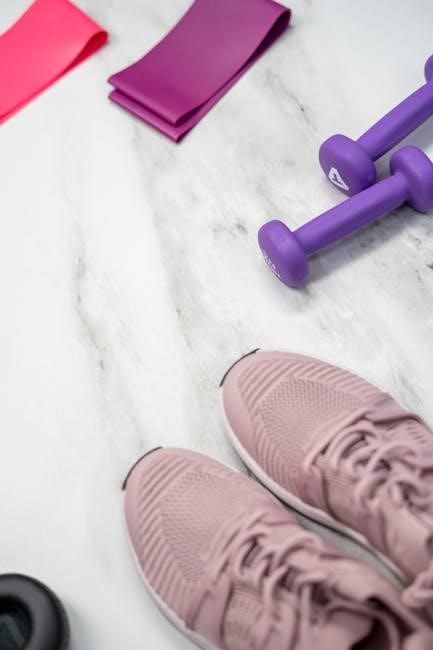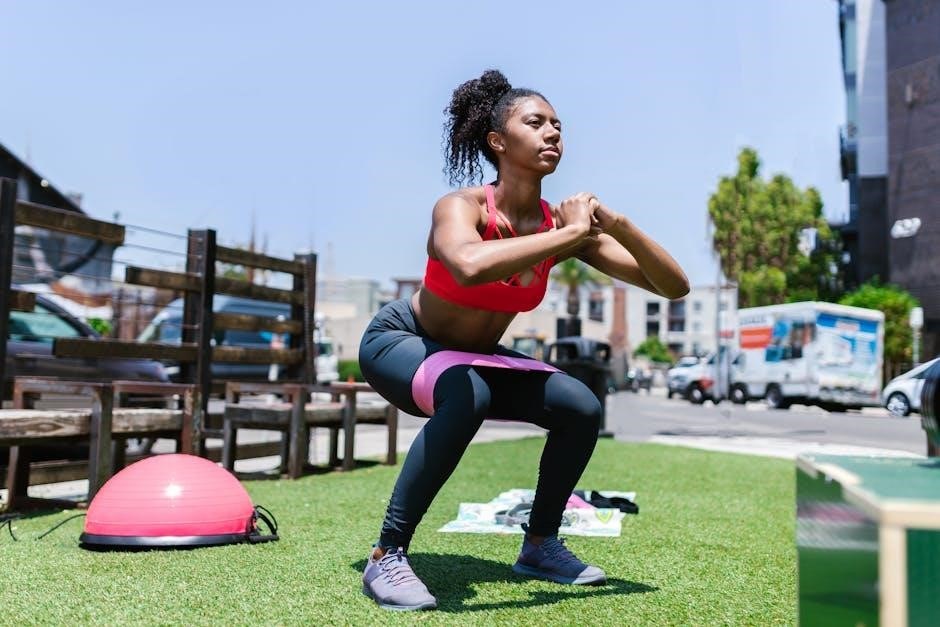Resistance bands are an excellent choice for beginners‚ offering versatility‚ portability‚ and effectiveness for full-body workouts. They suit all fitness levels‚ providing a cost-effective‚ space-efficient solution. This guide introduces a structured approach to building strength and confidence with resistance bands.
1.1 Benefits of Resistance Bands for Beginners
Resistance bands are a versatile and effective tool for beginners‚ offering a portable‚ cost-efficient way to build strength and improve flexibility. They provide adjustable resistance levels‚ allowing users to progress gradually as they gain strength. Unlike heavy weights‚ bands are lightweight and easy to store‚ making them ideal for home workouts. They also enable full-body exercises that target multiple muscle groups simultaneously‚ enhancing coordination and balance. Additionally‚ resistance bands are low-impact‚ reducing the risk of injury‚ making them suitable for all fitness levels‚ including those with mobility limitations.
1.2 Importance of a Structured Workout Plan
A structured workout plan is essential for maximizing results with resistance bands. It ensures consistency‚ progression‚ and balanced muscle development. By organizing exercises into specific days or muscle groups‚ beginners can avoid overtraining and prevent plateaus. A well-designed plan also helps track progress‚ set achievable goals‚ and maintain motivation. For those starting out‚ a 4-day split focusing on upper body‚ lower body‚ core‚ and full-body circuits is recommended. This approach promotes efficiency and ensures a comprehensive fitness routine tailored to individual needs and goals. Proper planning accelerates progress and keeps workouts engaging.
1.3 Overview of the Free Printable PDF Guide
The free printable PDF guide offers a comprehensive‚ illustrated resource for beginners to master resistance band exercises. It includes detailed step-by-step instructions‚ workout plans‚ and safety tips. Designed to be user-friendly‚ the guide covers full-body exercises‚ targeting upper body‚ lower body‚ and core muscles. Perfect for home workouts‚ it provides a structured plan to help track progress and stay motivated. Whether you’re just starting out or seeking to enhance your routine‚ this guide ensures a fun and effective fitness journey with resistance bands.

Setting Up Your Resistance Band Workout
Setting up your resistance band workout involves anchoring the bands securely‚ choosing the right resistance level‚ and following safety tips to ensure effective and injury-free exercises.
2.1 How to Anchor Resistance Bands at Home
Anchoring resistance bands at home is simple and effective. Use a sturdy door by folding a towel‚ placing it in the doorway‚ and closing the door securely. Ensure the band is tightly wedged between the door and frame for stability. This setup allows for a variety of exercises like rows and presses. Always check the anchor point for safety before starting your workout to prevent accidents. Proper anchoring ensures a smooth and effective exercise experience.
2.2 Choosing the Right Resistance Level
Selecting the right resistance level is crucial for an effective workout. Resistance bands come in various levels‚ often color-coded for ease. Start with a lighter resistance to focus on proper form and technique. As you gain strength‚ gradually increase the resistance. You can also adjust the band’s length or double it up for added challenge. Choose a resistance that allows you to complete the desired number of repetitions with good form but still feels challenging. This ensures a safe and progressive workout experience.
2.3 Safety Tips for Using Resistance Bands
Before starting‚ inspect the resistance band for any tears or damage. Anchor the band securely to prevent it from snapping during exercises. Begin with lighter resistance and gradually increase as you build strength. Maintain proper form to avoid injury and focus on controlled movements. Avoid overstretching the band‚ as it may lose elasticity or break. Keep the band away from your face and eyes during use. Warm up before your workout and listen to your body to ensure a safe and effective session.

Full-Body Resistance Band Exercises for Beginners
Resistance bands offer a versatile and effective way to engage in full-body workouts‚ targeting major muscle groups for strength and flexibility‚ perfect for home or travel‚ balancing upper and lower body exercises for overall fitness.
3.1 Upper Body Exercises
Resistance bands are ideal for strengthening the upper body‚ targeting muscles like the chest‚ shoulders‚ and arms. Exercises such as chest presses‚ seated rows‚ and shoulder presses effectively build strength and endurance. For beginners‚ these exercises are easy to perform and require minimal setup. The bands provide gradual resistance‚ allowing you to progress as you gain strength. Proper form is crucial to avoid injury and maximize results. Start with lighter resistance and increase as you become more comfortable with the movements. This approach ensures a safe and effective upper body workout at home or on the go.
3.2 Lower Body Exercises
Resistance bands are excellent for strengthening the lower body‚ targeting muscles like the legs‚ glutes‚ and hips. Exercises such as squats‚ lunges‚ and leg abductions are perfect for beginners‚ improving balance and stability. These movements mimic everyday actions‚ making them functional and practical. Start with basic techniques and gradually increase resistance as strength improves. Proper form is essential to prevent injury and maximize results. Incorporating these exercises into your routine will help build a strong foundation for overall lower body fitness and mobility.
3.3 Core Strengthening Exercises
Resistance bands are an excellent tool for strengthening the core‚ which includes the abs‚ obliques‚ and lower back. Exercises like plank rows‚ Russian twists‚ and seated crunches can be modified to suit all fitness levels. These movements improve stability‚ balance‚ and overall posture. By incorporating resistance bands‚ you can add variety and intensity to your core workouts. Start with basic techniques and gradually increase resistance as you build strength. Consistency in these exercises will enhance your core stability and support your overall fitness journey.

Step-by-Step Exercise Guides
Master resistance band exercises with detailed step-by-step instructions; Each guide provides clear explanations‚ proper form tips‚ and modifications for beginners‚ ensuring a safe and effective workout experience.
4.1 Squats with Resistance Bands
Performing squats with resistance bands is an effective way to strengthen the lower body. Start by anchoring the band at hip height or under your feet. Stand with feet shoulder-width apart‚ holding the band securely. Engage your core‚ lower into a squat‚ and push through your heels to return to the starting position. Focus on proper form to avoid injury. This exercise targets the quadriceps‚ glutes‚ and hamstrings. Beginners can modify the resistance level by adjusting the band’s tension or using a lighter band. Aim for 10-12 reps per set.
4.2 Banded Chest Press
The banded chest press is an excellent exercise for targeting the chest muscles. To perform‚ anchor the resistance band at chest height behind you. Sit or stand facing the anchor point‚ holding the band in both hands at shoulder height. Press the band forward‚ extending your arms fully‚ then slowly return to the starting position. Keep your core engaged and maintain proper posture throughout the movement. This exercise helps build chest strength and improves overall upper body stability. Beginners can start with lighter resistance and gradually increase as they build strength.
4.3 Seated Row with Resistance Bands

The seated row with resistance bands is a great exercise for targeting the back muscles‚ including the latissimus dorsi and rhomboids. To perform‚ sit on the floor with your legs extended and loop the resistance band around a stable anchor point in front of you. Hold the ends of the band in each hand‚ keeping your feet flexed. Pull the band toward your chest‚ squeezing your shoulder blades together‚ then slowly release to the starting position. This exercise helps improve posture and strengthens the upper back muscles‚ essential for beginners building a strong foundation.
4.4 Banded Lunges
Banded lunges are an excellent exercise for targeting the lower body‚ particularly the quadriceps‚ hamstrings‚ and glutes. To perform‚ place the resistance band around your thighs or ankles‚ depending on the desired intensity; Stand with your feet shoulder-width apart‚ engage your core‚ and keep your chest upright. Step forward into a lunge‚ lowering your body until both knees are at 90 degrees‚ then push back to the starting position. Focus on maintaining proper form to avoid injury and maximize results; This exercise improves balance‚ strength‚ and mobility‚ making it a great addition to any beginner’s routine. Start with lighter resistance and gradually increase as you build strength.
4.5 Leg Abduction Exercises
Leg abduction exercises with resistance bands target the gluteus medius and other hip muscles‚ improving strength and stability. Sit on the floor with your legs straight‚ loop the band around your ankles‚ and hold the ends for control. Slowly spread your legs apart against the resistance‚ then bring them back together. Perform 3 sets of 15-20 repetitions‚ keeping movements smooth and controlled. This exercise helps prevent knee and hip injuries while enhancing balance and posture. It’s ideal for beginners looking to strengthen their lower body and core stability effectively.

4.6 Banded Shoulder Press
The banded shoulder press is an effective exercise for targeting the deltoids and trapezius muscles. Stand with the resistance band looped behind your back‚ holding the ends at shoulder height. Press the band upwards‚ extending your arms fully‚ then slowly lower it back to the starting position. Aim for 3 sets of 10-15 repetitions. This exercise helps build shoulder strength‚ improve posture‚ and enhance overall upper body stability. Keep your core engaged to maintain proper form and avoid arching your back. Focus on controlled movements for maximum effectiveness and injury prevention.

Building a 4-Day Workout Plan
A 4-day resistance band workout plan balances upper body‚ lower body‚ core‚ and full-body circuits‚ ensuring progressive strength gains and muscle engagement while maintaining beginner-friendly intensity levels.
5.1 Day 1: Upper Body Focus
Day 1 targets the chest‚ shoulders‚ and arms with exercises like banded chest presses‚ shoulder presses‚ and rows. Start with 3 sets of 10-12 reps for each exercise‚ ensuring proper form. Use lighter resistance to focus on technique and gradually increase intensity. Warm up with 5 minutes of light cardio‚ and rest for 30-45 seconds between sets. This structured approach helps build foundational strength and endurance in the upper body while maintaining a beginner-friendly pace.
5.2 Day 2: Lower Body Focus

Day 2 emphasizes strengthening the legs‚ glutes‚ and hips through exercises like banded squats‚ lunges‚ and leg abductions. Perform 3 sets of 12-15 reps per exercise to build foundational strength. Start with moderate resistance to ensure proper form. Incorporate dynamic stretches during your warm-up to prepare your lower body. Rest for 45-60 seconds between sets to maintain intensity. This focus helps improve balance‚ stability‚ and overall lower body endurance‚ essential for daily activities and advanced workouts.
5.3 Day 3: Core and Stability
Day 3 focuses on building a strong core and improving stability with resistance band exercises like seated rows‚ banded planks‚ and rotational presses. Perform 3 sets of 10-12 reps per exercise to enhance core engagement and overall balance. Start with lighter resistance to maintain control. Incorporate deep breathing exercises during your warm-up to activate your core muscles. Rest for 45-60 seconds between sets. Strengthening your core improves posture‚ reduces injury risk‚ and enhances performance in other exercises. Keep movements slow and controlled for maximum effectiveness.
5.4 Day 4: Full-Body Circuit
Day 4 combines upper‚ lower‚ and core exercises into a circuit format for a comprehensive workout. Perform 3 sets of 10-15 reps for each exercise‚ resting minimally between exercises. Include squats‚ banded chest presses‚ seated rows‚ banded lunges‚ and leg abductions. This circuit enhances cardiovascular fitness and muscle endurance. Start with a dynamic warm-up to prepare your body. Focus on maintaining proper form throughout. Finish with a 5-minute cool-down to stretch major muscle groups. This full-body approach ensures balanced development and maximizes calorie burn‚ keeping you motivated and challenged.

Modifying Exercises for Beginners
Adjust resistance levels‚ use bodyweight assistance‚ or modify ranges of motion to suit fitness levels. Alternatives for limited mobility ensure inclusivity and safe progression in workouts.
6.1 Adjusting Resistance Levels
Beginners can modify resistance by doubling the band for more intensity or using a lighter band for ease. Start with lower resistance to focus on form‚ then gradually increase as strength improves. Proper form ensures safety and effectiveness. Always check the band for damage before use. Adjusting resistance levels allows for a tailored workout‚ making exercises accessible and challenging at every stage of fitness. This flexibility helps build strength progressively without risking injury.
6.2 Progressing to More Challenging Exercises
As beginners gain strength and confidence‚ they can progress to more challenging exercises by increasing resistance levels or altering movement dynamics. For example‚ transitioning from standard squats to weighted squats or incorporating single-leg exercises. Adding variations like pulses or holds enhances intensity. Gradually introducing more complex movements ensures continued growth without overexertion. This progression keeps workouts engaging and effective‚ helping to build muscle and improve overall fitness progressively.
6.3 Alternatives for Limited Mobility
For those with limited mobility‚ resistance bands offer adaptable exercises that can be modified to suit physical constraints. Seated exercises‚ such as seated rows or chest presses‚ are excellent alternatives that minimize strain while targeting key muscle groups. Additionally‚ chair-assisted movements or reducing the range of motion can make exercises more accessible. These modifications ensure a safe and effective workout‚ allowing individuals to progress at their own pace without compromising form or results.

Maximizing Your Workout Results
Consistency‚ proper form‚ and gradual resistance increases are key to maximizing results. Incorporating warm-ups‚ tracking progress‚ and setting achievable goals ensures steady improvement and long-term success.
7.1 Importance of Proper Form
Proper form is essential for maximizing the effectiveness of resistance band exercises and preventing injuries. Maintaining controlled movements ensures that the target muscles are engaged correctly. Keep your core muscles active to stabilize your body and maintain proper posture. Avoid sacrificing form for more repetitions‚ as this can lead to poor technique and potential harm. Focus on slow‚ deliberate movements to fully activate the muscles and achieve the best results from your workout routine.
7.2 Incorporating Warm-Up and Cool-Down Routines
A proper warm-up prepares your body for exercise by increasing blood flow and flexibility‚ reducing the risk of injury. Start with light cardio‚ such as arm circles‚ leg swings‚ or torso twists. Dynamic stretches‚ like high knees or lunges‚ can also be effective. After your workout‚ a cool-down helps your body recover. Stretch major muscle groups‚ focusing on deep breathing to relax your muscles. Incorporating these routines enhances workout effectiveness and supports overall well-being.
7.3 Tracking Progress and Setting Goals
Tracking your progress and setting clear goals are essential for staying motivated and measuring success. Use a workout journal to record exercises‚ reps‚ and resistance levels. Take progress photos or measurements weekly to visualize changes. Set both short-term and long-term goals‚ ensuring they are realistic and achievable. Celebrate small victories‚ like increasing resistance levels or completing more reps‚ to stay encouraged. Regularly reassess your goals to stay focused and motivated on your fitness journey.
Resistance bands offer a versatile‚ cost-effective way to build strength and fitness. With consistent effort and proper form‚ beginners can achieve meaningful progress. Use the free printable PDF guide to stay organized and motivated‚ ensuring a smooth transition to more advanced routines as your fitness journey evolves.
8.1 Summary of Key Takeaways
Resistance bands provide a versatile‚ portable‚ and cost-effective way to build strength and fitness for beginners. They allow for gradual progression‚ targeting all major muscle groups. Proper form is essential to maximize results and prevent injuries. A structured workout plan‚ including upper body‚ lower body‚ and core exercises‚ ensures balanced development. Tracking progress and setting realistic goals will keep you motivated. Incorporate warm-ups and cool-downs for optimal performance. The free printable PDF guide offers a comprehensive resource to help you stay organized and achieve your fitness objectives effectively.
8.2 Encouragement to Continue the Workout Routine
Consistency is key to seeing results with resistance band exercises. Every workout brings you closer to your fitness goals‚ improving strength‚ flexibility‚ and overall health. Celebrate small victories‚ like mastering a new exercise or increasing resistance levels. The convenience and portability of resistance bands make it easy to stay committed. Remember‚ progress takes time‚ but with dedication‚ you’ll achieve lasting results. Stay motivated‚ track your journey‚ and embrace the empowerment that comes with building a stronger‚ healthier you.
8.3 Resources for Further Learning
For continued growth‚ explore additional resources like downloadable PDF guides‚ video tutorials‚ and online communities. Websites offer free printable charts and detailed workout plans tailored for beginners. Utilize these tools to expand your routine and explore advanced techniques. Many platforms also provide structured 4-day or 12-week programs with progress tracking. Stay informed and motivated by subscribing to fitness blogs or channels dedicated to resistance band training.